Bird Of Paradise Plant Care: Strelitzia Growing Guide
Its bright, bold, exotic flowers make this striking accent plant easily recognizable. I lived in Santa Barbara, CA, where these plants are common, for ten years, and had a few growing in my garden. This details Bird Of Paradise plant care, mainly outdoors, with a brief section on growing it as a houseplant.
In Southern California, this plant is ubiquitous in the ground and containers. It’s common but loved nonetheless, so much so that it’s the official flower of Los Angeles.
I now live in Tucson, AZ, and occasionally see it in containers and planters. This isn’t its ideal growing climate, but that doesn’t stop it from being planted. The Yellow Bird Of Paradise and Red Bird Of Paradise (a different genus) are more suited for growing in the desert.
- Botanical Name: Strelitzia Reginae
- Common Name: Bird Of Paradise, Orange Bird of Paradise, Crane Flower, Crane Plant
Note: This post was published on 6/8/2016. It was updated on 2/16/2024.
Bird of Paradise Plant Care Guide
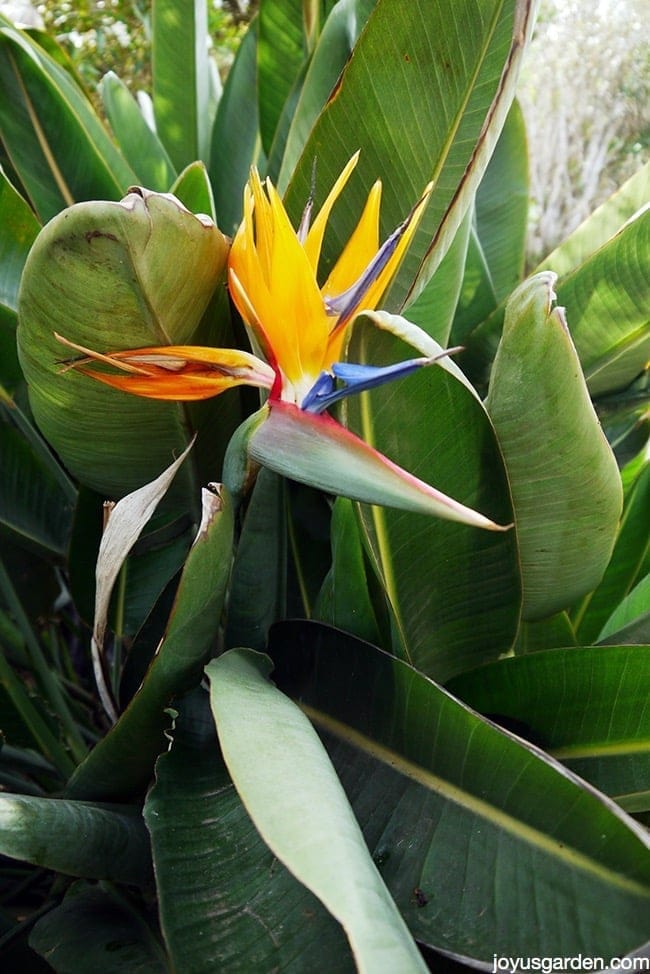
Bird Of Paradise Traits
Size
This subtropical/tropical clumping evergreen perennial can reach 4-6′ tall by 6-8′ wide in warm climates. It grows densely and reaches the size of a shrub, so space is needed for mature plants. Depending on the pot’s dimensions, the size is more restricted when growing in containers.
Uses
Many! Bird Of Paradise plants grow alongside sidewalks and streets, by the sea, poolside, in parking strips, container plantings, and in many gardens. It adds tropical vibes to any landscape.
Flowers
The orange and blue Bird Of Paradise flowers are the big draw for most. They’re long-lasting, on the plant and as cut flowers. More on BOP Flowering in a section further down.
Hardiness
They’re hardy to 25-30 degrees F. The Bird Of Paradise grows in USDA zones 10-12 and in zone 9 with protection from prolonged freezes. You can grow it outdoors in the warmer months and move it indoors when temperatures drop.
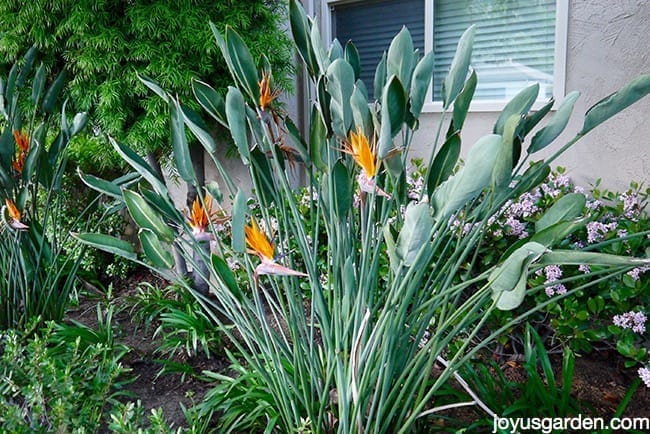
Bird Of Paradise Plants Outdoors
Light Requirements
The Bird Of Paradise grows the best and blooms the most in bright light. Full sun is fine along the coast of SoCal, where the maritime layer is prevalent.
It prefers partial shade inland and in places with blazing hot summers, like where I live in the Arizona desert.
Watering A Bird Of Paradise
The Bird Of Paradise looks and does the best with regular water – not too wet or too dry. Don’t give it a few splashes now and then, but a deep watering every 2-3 weeks in the warm growing season.
Southern California was experiencing a drought when I left in 2016. The foliage of this plant was not looking like it did pre-drought years. It was smaller and curled and brown on the edges.
New plants require more water than mature plants. Once plants are established, you can establish a watering schedule based on your environmental conditions.
Humidity
This tropical plant prefers high humidity. Along the California coast, in Florida and Hawaii, they get the humidity they like. Here in Tucson and Phoenix, they look less “robust” due to the dry air.
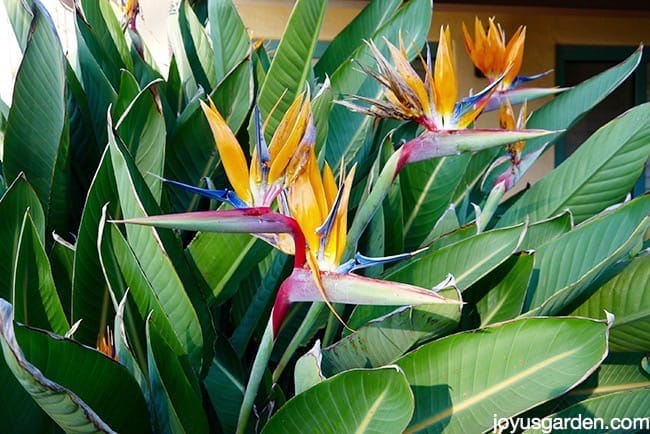
Feeding
They appreciate regular feeding during the growing season. Most of the ones that grew in public areas around Santa Barbara and other areas of SoCal didn’t get any. They looked good but would have benefited from a monthly feeding from early spring through early fall.
I never fertilized mine but fed them with a generous top dressing of organic compost, which also helped conserve moisture. If yours isn’t looking tip-top or the blooms are scarce, apply a balanced fertilizer like 5-5-5 or 10-10-0.
Soil
The Bird Of Paradise isn’t too fussy as to soil, as evidenced by the wide variety of places it grows in. However, It prefers a loamy, somewhat rich mix and needs good drainage.
Growing it in pots, a good quality potting soil with an amendment like pumice worked in, will aid drainage and aeration. It would appreciate compost, manure, or worm compost added for nourishment.
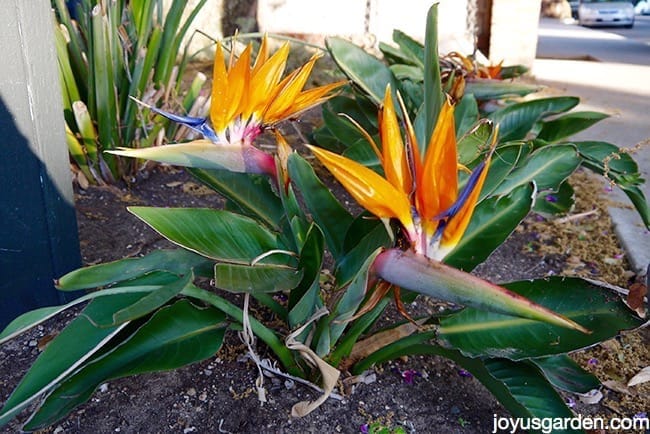
Repotting/Transplanting
Spring and summer are the best times to do this.
If you’re doing this for the first time, be warned: this plant has a dense, vigorous root ball. Crowded clumps bloom best, so don’t rush to transplant it.
You can repot yours as it grows. Once a plant has reached maturity and the pot size is proportional to the size of the plant, leave it. I saw large clumps in large pots growing all over SoCal, and they were doing fine and happily blooming away.
Pests
I’ve only seen them with mealybugs, but I have read that they can also be susceptible to scale and spider mites. A good blast with the garden hose will send those pests flying. Just be sure to get the undersides of the leaves and in the nodes as well.
A homemade spray with mild, natural dish soap and water will also help. If the infestation has worsened, neem oil and insecticidal soap are good options.
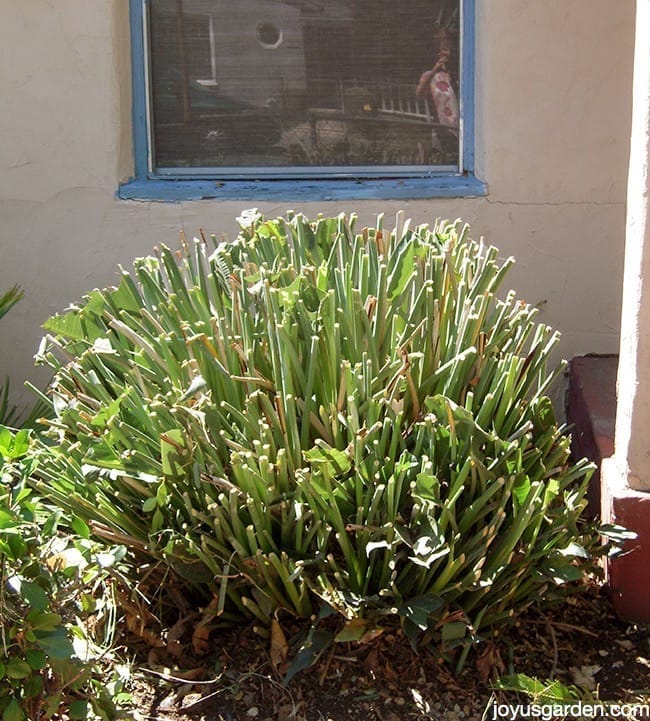
Pruning
Bird Of Paradise doesn’t require much regular pruning at all. You’ll want to remove the dead flowers, leaves, and unsightly foliage. Make sure your pruners are clean and sharp so you get even cuts.
Just be sure to take the stems down as close to the base of the plant as you can. You want to do the same with the dead flower stalks. Having dead stalks sticking up isn’t a good look!
Propagation
Spring through early summer is the best time to do this. That said, my neighbor divided his in late fall, and it did fine.
Division is the fastest way of propagating Bird Of Paradise plants. Crowded clumps bloom best, so don’t rush to divide a young plant. The root ball is strong, dense, and tough, so be prepared if you do divide one!
Bird Of Paradise Flowering
The crested orange flowers with accents of blue are what this plant is grown for, both in the landscape and commercially. The flowers are long-lasting on the plant as well as in floral arrangements.
When you plant a small Bird Of Paradise, don’t be surprised if it doesn’t flower for the 1st few years. Young plants don’t bloom.
As the plant ages, flowering increases. Don’t rush to divide because it blooms better when crowded.
It blooms the heaviest, in Southern California anyway, fall through spring and intermittently throughout the summer.
Are you asking how do I get my Bird Of Paradise to bloom? The most common reasons yours isn’t blooming are the plant isn’t old enough and the light is insufficient. Crowded clumps bloom best.

Bird Of Paradise Leaves
The green paddle-like leaves can develop brown edges due to too much or too little water, lack of humidity, or water quality.
Some of the older leaves get ratty due to strong wind. Split leaves are more common with the Giant Bird Of Paradise, but this one has them too. It’s how these plants grow – the leaves slit as they open.
If yours is growing indoors and the leaves are turning yellow, it’s usually due to the soil being kept too wet and/or the soil being too heavy.
Bird Of Paradise Outdoors in Pots
This plant does great in pots. As the plant grows and spreads, it’ll need a large pot to accommodate the vigorous root ball.
Just make sure the pot has drainage holes so excess water can flow out. They don’t like to sit in soggy soil.
Remember, a Bird Of Paradise with a crowded root ball blooms the best, so don’t repot yours yearly.
Bird of Paradise Plant Care Indoors
I’ve never grown this as an indoor plant. I have been growing a Strelitzia nicolai (The Giant Bird Of Paradise or White Bird Of Paradise) in my home in Tucson for two years, and the care is the same. Here are a few tips.
High light is the key. Give the Bird Of Paradise as much natural light as possible – it needs this brighter light for foliage and flower production. Be sure to rotate your plant (unless it gets light from all sides) so it grows evenly. Near but not in west-facing windows (no touching hot glass) is best.
Just like outdoors, it likes to grow crowded, so don’t rush to do any repotting. By keeping it potbound, you’ll get much better blooms.
You want to keep it slightly moist by giving it regular water. Back off on the watering in the cooler, darker months, allowing it to dry out before doing it again. This plant is susceptible to root rot, so don’t keep it “mushy.”
If many of the leaf edges are turning brown, one cause could be water quality. This plant is susceptible to a build-up of minerals in tap water. Try using filtered, rain, or distilled water. I have an under-sink tankless r/o system in my kitchen, which I use to water all my houseplants.
Our homes tend to be dry. You can create a more humid environment with a small humidifier nearby. Some like to use a saucer filled with pebbles and water and set the grow pot on top (ensure no roots stay soaked). An occasional misting a couple of times a week would also be appreciated.
You want to plant it in a nice, rich potting mix. A few handfuls of coco coir, pumice, and compost.
Make sure there’s at least one drainage hole on the bottom of the pot so the excess water can flow out. Don’t let your plant sit in a water-filled saucer.
In terms of feeding, you can give your Bird Of Paradise a drink with a balanced organic liquid houseplant fertilizer in spring. If it needs a little boost, do it monthly through the end of summer. We have a long growing season here, so I feed my Giant Bird Of Paradise 6 to 7 times a year. In the spring, you can apply a 2″ layer of organic compost and/or worm castings. This works slower, but the effects last longer.
It’s a good idea to clean the plant’s leaves every now and then. If you can’t put it in the shower or outside in the rain, then wipe the foliage with a dampened soft cloth now and then.
This plant is considered to be toxic. You can read about the degree of toxicity on the ASPCA website.
Bird Of Paradise Plant Care Video Guide
Birds Of Paradise Plant Care FAQs
It’ll tolerate shade, but the foliage will be smaller and the stems more stretched. Plus, it needs bright light to bloom.
My experience with this plant is with growing it outside. If yours grows indoors, you can put it outside for the warmer months. Just make sure to bring it back indoors before the temps dip below freezing.
Take them off, stem and all. You want to prune the stems back to the base of the plant.

In conclusion, This stunning accent plant is easy to care for outdoors (it’s one tough puppy) but is a little more of a challenge indoors. The big draw is the bold tropical foliage and bright, long-lasting blooms. It certainly will bring a touch of tropical beauty into your home or garden!
Happy gardening,

- About the Author
- Latest Posts
Nell, the founder of Joy Us garden, was born into a gardening family and grew up in Connecticut’s countryside. After living in Boston, New York, San Francisco, & Santa Barbara, she now calls the Arizona desert home. She studied horticulture & garden design, working in the field all her life. Nell is a gardener, designer, blogger, Youtube creator, & author. She’s been gardening for a very long time & wants to share what she’s learned with you.



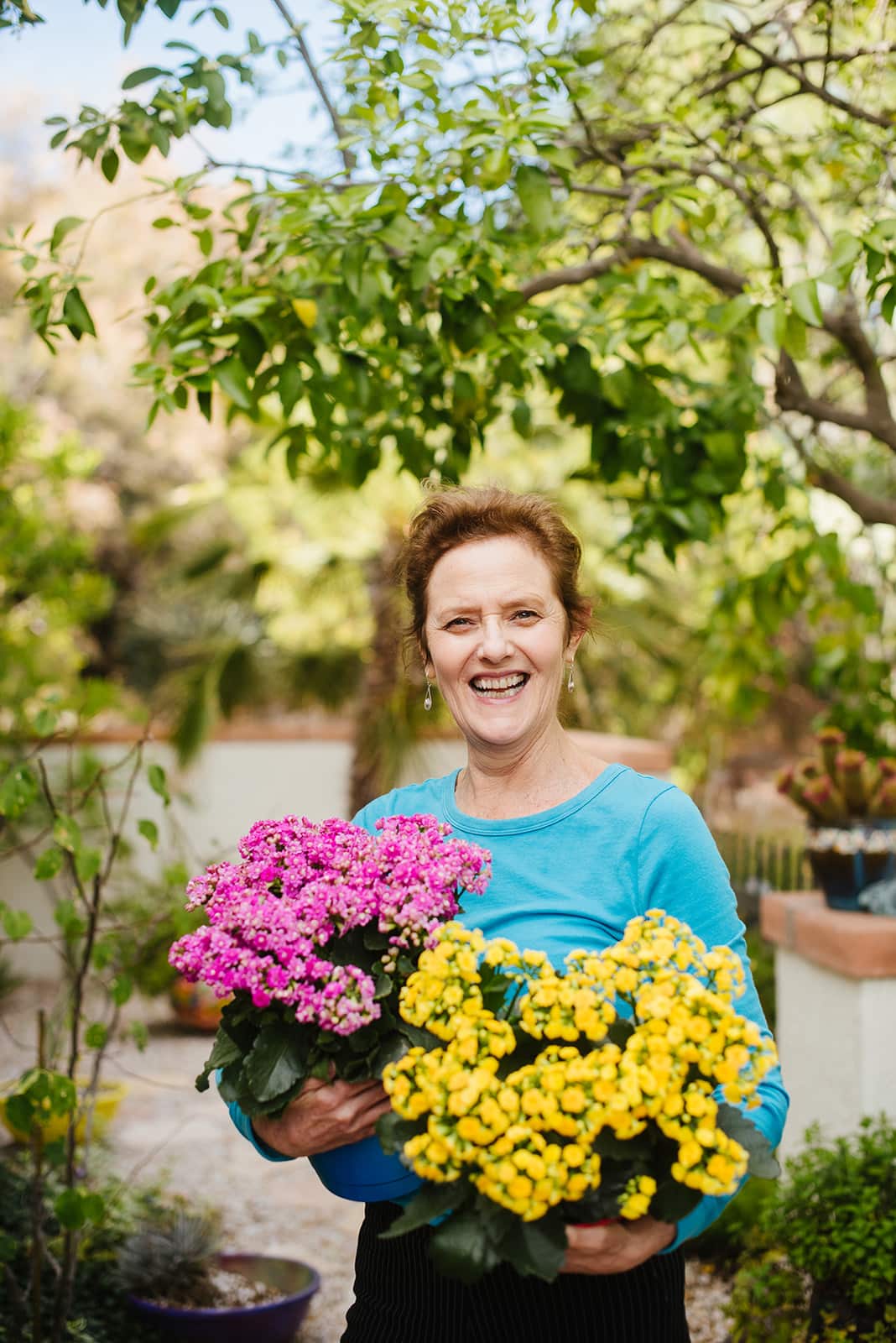
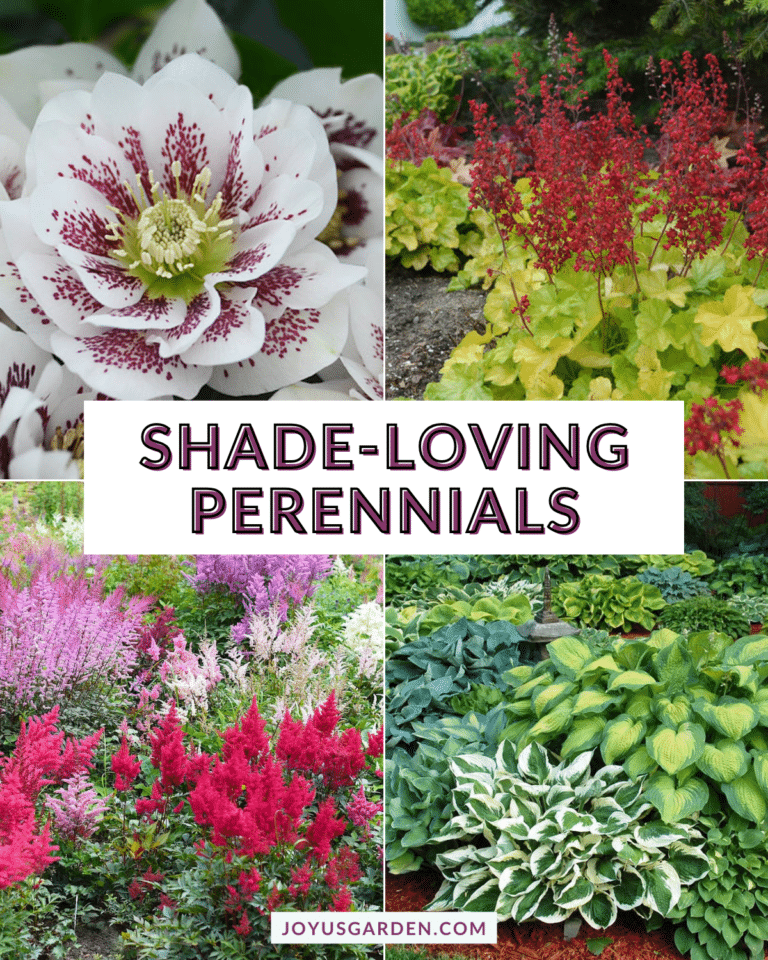
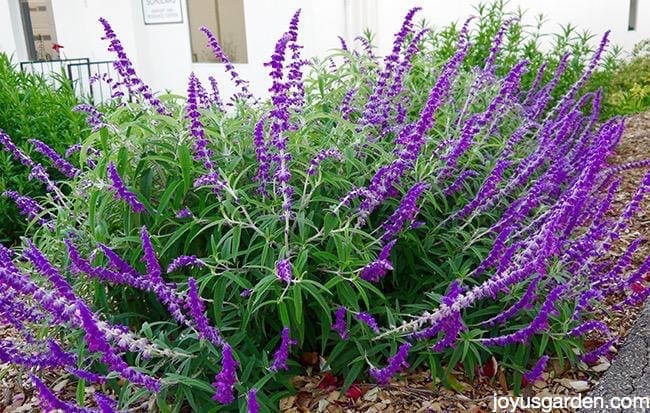
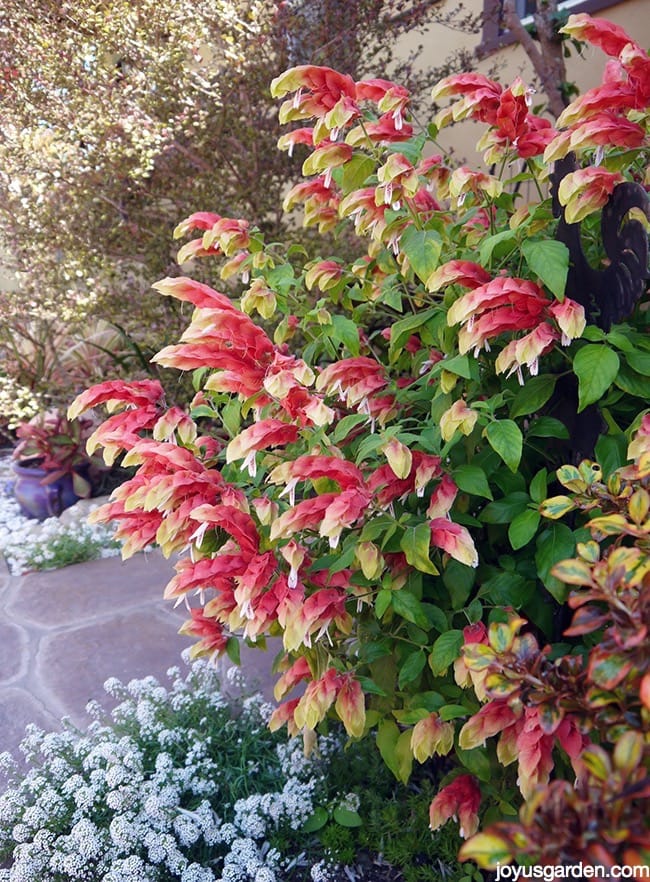
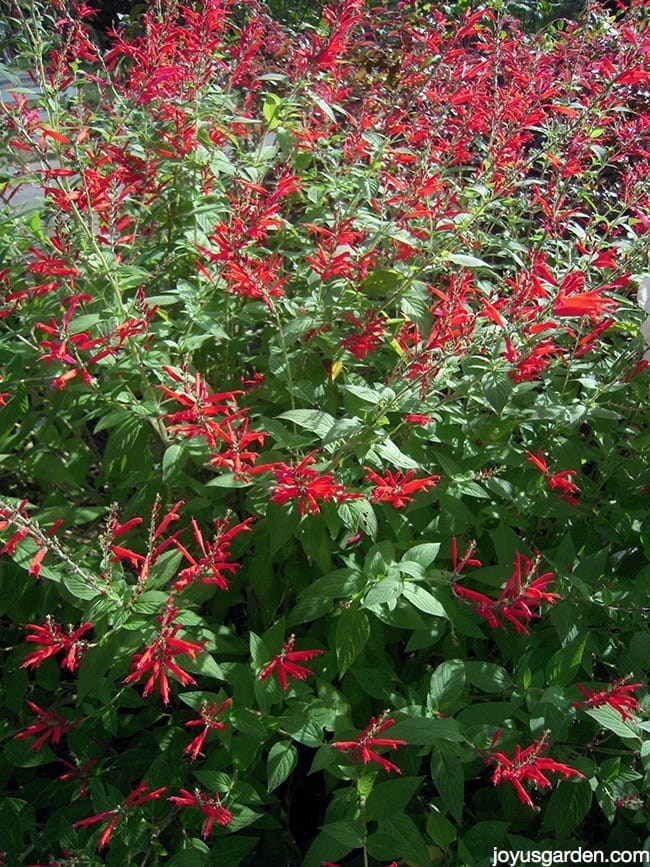

Hi there! I have had a BOP for At least 20 years. It has never bloomed. It’s been in the same pot the whole time. It has been in sun, and indirect light. What should I do to make it bloom?Hr,p!
Hi Sandra – They need around 6 hours of sun per day to bloom. Although they bloom best when tight in their pots, 20 years in the same pot is pushing it. Nell
I live in Ohio and my BOP is about 8-10 years old. I put the pot outside in summer and inside in winter months. I did transplant it summer. My BOP has never flowered. Any idea why? It looks great. During the winter Ohio is not known for sunshine and the house is not a sunny home either.
Thank you
Hi Pamela – BOPs bloom when older. Yours is old enough to bloom. They need lots of natural light (at least 6 hrs/day) to bloom. Nell
Hi Nell! Thanks for all the great tips! Just brought home my first white bird of paradise… Would you suggest waiting to re-pot until it’s a bit root logged? (trying) to keep it as in indoor plant.
Kate – The Giant Birds of Paradise has a very strong root system. If the roots are coming out the bottom or it’s looking stressed, then it’s time to repot. Nell
Hi Nell, I have a bird of paradise in full sun and have been pulling out the spent flowers instead of cutting them. Will this damage the plant? I also pull out the dead outer leaves for making the plant feel lighter. Should I cut instead of pull? Or as long as it comes out with a pull it won’t damage the plant? Many thanks
Sofia – Birds Of Paradise are very tough once established. If the spent flower stalk pulls off easily (or fairly easily!) I think it would be just fine. Nell